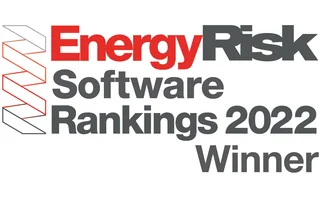
How energy risk managers are responding to extreme volatility


Changing energy market dynamics pose higher risks but also huge opportunities for risk managers that move swiftly, says Lacima’s Chris Strickland

Operating in gas and power markets has been particularly challenging in recent months as participants grapple with supply and demand uncertainty, price hikes and extreme volatility. In the first quarter of 2022, for example, European gas prices rose by around 70% in a single day on two separate occasions. Futures prices based on the Dutch gas hub TTF spiked 69% to €142 per megawatt hour (MWh) on February 24, and then surged a further 70% on March 7 to reach a record €345/MWh.
Even before the Russia–Ukraine crisis, the gas markets were in a state of flux as liquefied natural gas (LNG) grew in importance on the back of the energy transition. Traditional correlations between gas hubs have been falling, and LNG flows themselves are changing and becoming less predictable.
The energy transition is having an even greater impact in the power markets, where ever-increasing amounts of renewable energy are adding to the complexity of balancing supply and demand.
As a result, firms are trying to gain better insight into their risk exposures to properly understand the risks and opportunities of these new market dynamics. To do this, they need sophisticated models that take into account factors such as optionality in LNG contracts and various changing correlations, but also models they can deploy quickly to grab opportunities while they last.
Lacima, a software firm that performed very well in this year’s Energy Risk Software Rankings, is well placed to address both of these demands. It took six first places in this year’s survey, including Metrics, Analytics and Best enterprise risk management software system.
Here, Lacima’s chief executive, Chris Strickland, shares his insights into current market developments and how risk managers are responding.
Energy Risk: What impact is the current high volatility having on firm’s risk management? Are firms using new metrics or trying to measure new things?
Chris Strickland: Increases in volatility and in price in energy markets are having a huge impact across the complex, and firms want to understand that impact and potential future impact on their portfolios.
We’re seeing two main responses to the volatility. First, firms are looking at how they can structure deals to take advantage of it. To do this they need to understand, for example, how regional prices are moving in relation to each other and what flexibilities they have in their contracts. More often than not, this goes beyond standard exchange-traded options.
The current market conditions present some fantastic opportunities that weren’t present before, particularly in the gas markets, but firms need to be set up and ready to go. This environment works well for our Lacima Trader product suite as it’s really aimed at structuring deals very quickly in response to a particular set of circumstances. Firms need to respond very rapidly when there’s a lot of volatility, and therefore they need flexible tools that allow them to be agile.
The second thing firms want now is greater insight into their risk exposure calculations. For example with value-at-risk numbers rising rapidly, senior management and boards are asking more questions about why these numbers are rising. Risk managers need to know what’s driving them specifically. They may have hundreds of thousands of trades in their portfolios, and trade across tens or hundreds of curves, and so they want to know if, for example, the rise is because of changes in a particular commodity or regional spread, or whether it’s coming from their prop trading book or from a particular trader.
So, from a risk perspective, the emphasis is not so much on producing new metrics in response to the current volatility, but on getting insights into what is driving existing metrics and how they are changing day-on-day.
Additionally, stress-testing and ‘what if’ analysis becomes more important in times of unprecedented volatility because the historical data that’s typically used to calibrate models may no longer reflect current and future circumstances. For example, TTF prices rising 70% in a matter of hours – that’s never happened before, so it’s not going to be fully reflected in the parameterisation of the model. So firms are carrying out stress tests to see, for example, what would happen to their portfolio if the price rose to that level again and stayed there, or what if there were a dislocation between [UK hub] NBP and TTF.
So the emphasis again is not necessarily on new metrics, it’s stress-testing your existing metrics. Again, for us, that’s ideal because we’ve always tried to build that kind of insight into our analytics.
The volatility has also very much put the focus on the cost of trading, in particular the cost of variation margin. In some cases, margin has increased 10 times. Margin calls for some firms have now reached around $1 billion. So they want to know where margin calls might be going from here. For example, if TTF goes up by 70% again, what would that mean for my margin call?
Energy Risk: What trends have you seen around analytics as a result of firms wanting to gain greater insight into the impact of the Russia–Ukraine crisis?
Chris Strickland: The response is very much around gaining greater insight into the numbers and on performing stress tests: what if things stay like this? What happens if the war ends soon? What happens if it drags on for two more years?
Energy Risk: What problems are firms telling you they need to solve around the energy transition?
Chris Strickland: Firms struggle with incorporating new assets and contracts into their existing risk calculations and need greater insight into the variables surrounding renewable energy. Here you need to model not only price and demands but also supply-side issues such as wind speeds, solar radiance, temperatures and hydrological flows. Unlike financial markets, exposures in energy markets are not just to prices. Additionally, forecasts cannot necessarily be based on last year’s data. For example, Europe’s 2021 summer had below-average wind. Firms that had already sold forward power from their wind turbine had to buy it at market rate, which was relatively high because of the absence of wind power coming on to the grid.
Lacima has the stress-testing tools and scenario analysis for firms to run this sort of analysis. We don’t need to create a new system for them; it can all be done within our existing Lacima Analytics framework.
Energy Risk: Lacima recently developed an LNG valuation tool and a shipping optimisation engine. Why did you develop them and what do they do?
Chris Strickland: The LNG market has grown very quickly in recent years, and there is now much greater flexibility in the way it can be traded. The growth of the spot market and the increased number of LNG facilities worldwide have increased optionality around physical delivery. As a result, more and more firms want to understand the value of the flexibility clauses contained in their contracts.
Individual flexibility terms are often worth hundreds of millions of dollars, so understanding and valuing flexibility can make, or break, LNG businesses. But it is extremely challenging. Flexibilities embedded in a contract are often interdependent, requiring a series of decisions. Additionally, decisions need to work within the constraints of existing shipping programmes. Across an entire portfolio, the flexibility and embedded optionality is even more challenging.
Lacima developed two tools: one that helps firms value and understand the optionality embedded in their contracts, and a second that optimises shipping schedules for a portfolio of LNG deals. In the current environment, the flexibility clauses built into contracts can be worth more than the underlying intrinsic deal, and this creates huge potential profits but also enormous risks.
Lacima’s deal valuation and shipping optimisation products have a robust modelling framework that doesn’t oversimplify the flexibility clauses. It can accurately handle the complex interrelationships between various gas, oil and freight variables, as well as the interlinked flex components.
Energy Risk: What technologies are you looking at to advance your business?
Chris Strickland: The next horizon for us on the technology front would be to move towards web-based and hosted offerings. There’s obviously a trade-off, as web-based offerings need to be much more standardised, and often people come to us with very bespoke problems involving complex contracts and physical assets. But we can see things are definitely moving the way of web-based and hosted applications, especially for newer companies that want to keep their IT infrastructure lean.
Energy Risk: Do you see any breakthroughs in the use of machine learning for analytics any time soon?
Chris Strickland: A lot of firms are still struggling with just the basics. For example, they calculate the intrinsic valuation of their storage but do nothing to estimate the extrinsic value. Many firms look at thermal assets as a series of spread options without taking into account any of the characteristics of their power plant, or the embedded optionality in their LNG contracts. Very few players are at a point where they could start to develop machine learning algorithms. One of the problems is that training the algorithm is very resource heavy. Also, the risk of getting it wrong is so high. When you’re talking about margin calls of $1 billion, an inaccurate algorithm could be catastrophic.
It really comes back to sticking to the basics. What people need is fast, accurate and reliable analytics, and this is something we can give them.
See the full Energy Risk Software Rankings 2022 results
Sponsored content
Copyright Infopro Digital Limited. All rights reserved.
As outlined in our terms and conditions, https://www.infopro-digital.com/terms-and-conditions/subscriptions/ (point 2.4), printing is limited to a single copy.
If you would like to purchase additional rights please email info@risk.net
Copyright Infopro Digital Limited. All rights reserved.
You may share this content using our article tools. As outlined in our terms and conditions, https://www.infopro-digital.com/terms-and-conditions/subscriptions/ (clause 2.4), an Authorised User may only make one copy of the materials for their own personal use. You must also comply with the restrictions in clause 2.5.
If you would like to purchase additional rights please email info@risk.net